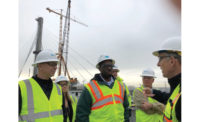Peter Sluszka
New York City
ENR 1/11-18/16 p. 14
Persevered in getting bridge owners to try an anticorrosion cable dehumidification system, created in Japan.
When Peter Sluszka worked for the renowned bridge firm Steinman Boynton Gronquist & Birdsall in the 1980s, he saw the rehabilitation of corroded, ungalvanized cables—steel wire, coated with zinc and oiled—on the Williamsburg Bridge. In the 1990s, engineers tried wrapping bridge cables with neoprene to prevent corrosion. “I always thought that there had to be a better way,” he says.
Then, he heard that Japanese engineers were experimenting with dry-air injection—dehumidification systems—on the Honshu–Shikoku bridge network. “I was skeptical. How do you do that? Is it a complicated system? Is it reliable?”
In 2002, Sluszka got the chance to take a look for himself. “We saw it up close. They even had viewing windows to look beneath the wrapping. The system was working perfectly—the cables were completely dry. I saw it was not a complex thing to do. It was fairly simple, practical, and it really worked.”
Along with colleagues at Ammann & Whitney, now the long-span-bridge arm of Louis Berger Group, he spent the next decade convincing U.S. clients to try the system of plant rooms that pipe dry air into cables through injection sleeves. “We got the Port Authority of New York & New Jersey to accept the concept” for the George Washington Bridge’s $1-billion suspender-rope replacement project.
But the Maryland Transportation Authority (MDTA) edged out the port authority in being the first to try the dehumidification system. “We began inspecting the [Cheseapeake Bay] bridge and found corrosion. We said, ‘Those cables should be dehumidified,’ ” says Sluszka. The agency agreed, and Ammann & Whitney, along with AECOM, TY Lin International and HNTB, designed the $53-million system that Kiewit finished installing last year on the dual 4.3-mile spans.
“As a technical adviser to MDTA, I peer-reviewed the recommendations for the Bay bridge,” says Jamey Barbas, Thruway Authority project director for the New New York Bridge. “Peter was a staunch proponent of a well-planned dehumidification system as a means to extend the service lives of vital suspension bridges.”
The Delaware River and Bay Authority is now installing or conducting tests on several bridges. “More clients are convinced this is a good thing to do,” says Sluszka.




Post a comment to this article
Report Abusive Comment